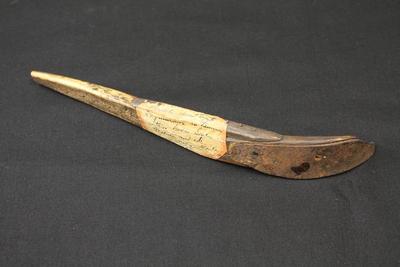E0185: Inuit- Knife
Ethnographic
Identifier:
E0185Classification Category:
10:Unclassifiable Artifacts ➞ Multiple Use ArtifactMarks/Labels:
TAG: "utensils used by the Esquimaux in tanning their hides. Seal, Walrus and etc. From Nome Alaska 1903" and "Tools used for tanning hides Nome, Alaska. 1903"**Esquimaux is the French spelling for Eskimo.
Materials:
animal ➔ bonemetal
botanical ➔ wood ➔ unidentified
Dimensions:
24.5 cm L3.5 cm W
Provenance of Object:
Alaska, (Nome), U.S.This object was held in the museum that Luther College started in 1877. This museum eventually grew into the Vesterheim Norwegian-American Museum, and following this, non-Norwegian American ethnographic objects were returned to Luther and accessioned into the college’s Anthropology Collection. Without additional documentation, was likely obtained by the Luther College Museum (later the Norwegian-American Museum) between the late 19th century and early 20th century.
Production Date:
Late 19th Century-Early 20th CenturyUse/Function:
"Use for fine whittling and carving on wood, ivory, bone, etc., "crooked knives" consisting of a small blade, set on the under side of the end of a long curved haft. Mad of iron or steel, intended specifically for cutting bone and ivory. The knife is held close to the blade between the index and second fingers of the right hand with the thumb over the edge, which is toward the workman." - Murdoch, John. Point Barrow Expedition. p. 57Brevig Book: “The natives’ method is to cut off a piece from the meat in the bowl, bite this piece firmly, and then by the use of a knife, cut off a proper size which could be swallowed.”

